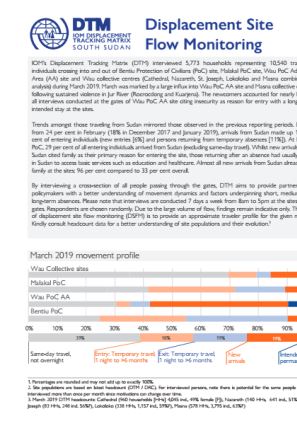-
Countries
-
Data and Analysis
-
Special Focus
-
Crisis Responses
South Sudan
South Sudan
IDPs tracked
Displacement Movements
1,475,000
IDMC 2022
Data collection round
About South Sudan
Conflict and instability in South Sudan have resulted in large-scale internal and cross-border displacement since the December 2013 crisis of over 4 million individuals. In September 2018, the Revitalized Agreement for the Resolution of the Conflict in South Sudan (R-ARCSS) was signed between the major warring parties. Whilst overall there have been improvements in security since and returns are ongoing, fighting and communal clashes (frequently linked to cattle raiding) continue to trigger new displacements and the situation remains volatile.
DTM South Sudan’s toolbox is designed to meet critical information gaps during all phases of response, from preparedness, to intervention and transition/recovery. DTM South Sudan provides country-wide figures on the numbers, locations and priority needs of IDPs and returnees updated on a quarterly and ad-hoc basis. The programme undertakes biometric registration in selected parts of the country to support partners with reaching intended beneficiaries during distributions. Flow monitoring data is collected on a daily basis at displacement sites, key transit hubs and border crossing points to identify mobility dynamics of migrants including IPDs and returnees. Through ad hoc surveys, headcounts, infrastructure/service mapping exercises and other assessments, DTM provides additional information to support partners in planning their response.
Contact
IOM South Sudan DTM Juba
ISSDTM@iom.int
Current Donors
- Switzerland
- Japan
- DFID
- ECHO
- OCHA
- OFDA
- Canada (DFATD)
- WFP
- UN Peacebuilding Fund
- World Bank
South Sudan — Biometric registration update (June 2019)
IOM’s biometric registration system has been active since 2014, with 821,278 beneficiaries active in its database to date, out of which 56% (460,569 individuals) are women; and 60.8% (499,264 individuals) are under 18 years old.
South Sudan — Mobility Tracking Report 5 (19 July 2019)
During Round 5 of Mobility Tracking (March 2019), 1,420,189 IDPs and 1,183,683 returnees were identified.52,268 IDPs arrived Jan-March 2019.534,082 returnees, 39% of whom came from abroad,came back since R-ARCSS (Sept 2018 - March 2019). In Round 5, DTM accessed 1,
South Sudan — Sites Catalogue — Mobility Tracking Round 5
This catalogue presents multi-sectoral profiles for all assessed IDP camps and camp-like settings in South Sudan, based on DTM’s Mobility Tracking Round 5 data (data collection March 2019). Please use the interactive table of contents to navigate the report.
South Sudan — Biometric Registration Update (May 2019)
IOM’s biometric registration system has been active since 2014, with over 776,000 beneficiaries active in its database to date.
South Sudan — Ebola Preparedness Flow Monitoring Dashboard (May 2019)
As part of IOM’s Ebola Virus Disease (EVD) preparedness activities, DTM operates Flow Monitoring Points (FMPs) on the borders with Uganda (UGA), the Democratic Republic of Congo (DRC) and the Central African Republic (CAR). In total, 21 EVD-dedicated FMPs were active in May.
South Sudan — Flow Monitoring Dashboard (May 2019)
DTM’s Flow Monitoring Registry (FMR) surveys people on the move at key transit points within South Sudan (SSD) and at its borders.
South Sudan — Mobility Tracking: IDPs and Returnees by sub-area
IOM’s Displacement Tracking is pleased to share with you several maps and a dataset detailing data on the numbers and locations of IDPs and returnees in all counties for 444 sub-areas (payam) disaggregated by period of displacement / return (data collection in March 2019).
South Sudan — Mobility Tracking Round 5 Baseline Locations Summary
This summary represents findings for the fifth round of Mobility Tracking, conducted in South Sudan through key-informant based assessments at sub-area and location levels.
South Sudan — Map: Mobility Tracking Round 5 — Locations By Type As Of March 2019
This map, based on Mobility Tracking Round 5 Baseline data, shows locations hosting IDPs and returnees by type in South Sudan as of March 2019.
South Sudan — Map: Mobility Tracking Round 5 — Returnees By County As Of March 2019
This map, based on Mobility Tracking Round 5 Baseline data, shows the number of returnees by county in South Sudan as of March 2019.
South Sudan — Map: Mobility Tracking Round 5 — IDPs by county as of March 2019
This map, based on Mobility Tracking Round 5 Baseline data, shows the number of IDPs by county in South Sudan as of March 2019.
South Sudan — Event Tracking: Tambura (May 2019)
The International Organization for Migration’s Displacement Tracking Matrix (DTM) has identify 446 IDPs (174 Households) in Tambura Centre (Tambura County), Western Equatoria confirming recent reports of new displacement in the area.
Jun 07 2019
South Sudan — Event Tracking: Tambura (May 2019)
South Sudan — Ebola Preparedness Flow Monitoring Report (January-April 2019)
As part of IOM’s Ebola Virus Disease (EVD) preparedness activities, DTM operates Flow Monitoring Points (FMPs) on the borders with Uganda (UGA), the Democratic Republic of Congo (DRC) and the Central African Republic (CAR).
South Sudan — Wau PoC AA Headcount (May 2019)
Throughout 2018 until February 2019, DTM observed a steady decline of Wau PoC AA site’s population. However, between March and May, the population increased by 30 per cent (by 4,248 individuals).
Jun 07 2019
South Sudan — Wau PoC AA Headcount (May 2019)
South Sudan — Displacement Site Flow Monitoring (April 2019)
IOM’s Displacement Tracking Matrix (DTM) interviewed 2,613 households representing 5,216 travelling individuals crossing into and out of Bentiu Protection of Civilians (PoC) and Malakal PoC site during April 2019.
South Sudan — Flow Monitoring Dashboard (April 2019)
DTM’s Flow Monitoring Registry (FMR) surveys people on the move at key transit points within South Sudan (SSD) and at its borders.
South Sudan — Biometric Registration Update (April 2019)
IOM’s biometric registration system is active since 2014, with over 700,000 beneficiaries active in its database to date.
South Sudan — Biometric Registration Update (March 2019)
IOM’s biometric registration system is active since 2014, with over 700,000 beneficiaries active in its database to date.
South Sudan — Ebola Preparedness Flow Monitoring Dashboard (April 2019)
As part of IOM’s Ebola Virus Disease (EVD) preparedness activities, DTM operates Flow Monitoring Points (FMPs) on the borders with Uganda (UGA), the Democratic Republic of Congo (DRC) and the Central African Republic (CAR).
South Sudan — Wau PoC AA Headcount (April 2019)
Wau PoC AA population, April 2019: 16,284 individuals (49% Female)
May 20 2019
South Sudan — Wau PoC AA Headcount (April 2019)
South Sudan — Event Tracking: Wau (May 2019)
The displacement caused by the clashes between pastoralists and farmers in Kuarjena and Rocrocdong, Jur River that broke out in early March 2019 continues within the county and beyond, as reported on 15 March 2019 (
May 15 2019
South Sudan — Event Tracking: Wau (May 2019)
South Sudan — IOM / UNHCR Intention-Perception Survey – Malakal (May 2019)
Following the recommendation from the Upper Nile Solutions Working Group, IOM and UNHCR conducted a joint survey in Malakal Protection of Civilian Site (PoC) to establish people’s intentions to return, the tentative time frame of return or relocation and preferred destinations, as well as present
South Sudan — Ebola Preparedness Flow Monitoring Dashboard (March 2019)
As part of IOM’s Ebola Virus Disease (EVD) preparedness activities, DTM operates seven Flow Monitoring Points (FMPs) in Yambio, Yei and Morobo counties and six in cooperation with DTM Uganda on the Ugandan side of the border.
South Sudan — Displacement Site Flow Monitoring (March 2019)
March was marked by a large influx into Wau PoC AA site and Masna collective centre following sustained violence in Jur River (Rocrocdong and Kuarjena).
Pagination
Pagination
- First page
- Previous page
- 1
- 2
- 3
- 4
- 5
- 6

























